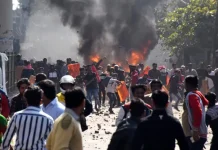Ukrainian President Volodymyr Zelenskyy looks straight into the camera with the quality of an amateur vlogger. Wearing a T-shirt and sweater, he names the official titles of those standing with him: high-ranking Ukrainian officials who are similarly casually dressed.
“All of us are here protecting our independence of our country,” Zelenskyy said calmly in the first days after Russia’s invasion of Ukraine, according to a translation.
This is just one example of how the country under attack has been fighting the information war against Russia, as many inexperienced Ukrainian fighters, including civilians, challenge the foreign troops on the ground.
While an underdog in the ground battle, Ukraine is so far winning the fight for hearts and minds, including in pockets of Russia where protests have broken out, and within many countries that have gone farther than expected in providing support.
“Zelenskyy was not seen as a very effective leader two weeks ago. Now he is a Churchill-like figure,” said Marc Polymeropoulos, a retired Central Intelligence Agency official who worked as head of clandestine operations in Europe and Eurasia. “And that’s because of [the Ukrainians’] use of information operations, social media, to put forth the kind of notion of these brave defenders fighting not only for their Ukrainian freedom, but for Europe.”
The early-stage victory in the information domain has had tangible benefits for Ukraine, which has seen harsh sanctions on Russia imposed by the U.S. and the European Union and grassroots financial support. How long Ukraine can continue to capture the world’s attention is still to be determined. But while several experts who spoke with CNBC agreed Russia had underestimated Ukraine’s resilience, including in the information sphere, its disinformation and propaganda tactics will likely continue to target people in both countries should the war drag on.
How winning social media narrative fuels ground advantages
Ukraine’s ability to win the narrative has significant implications for three important constituencies: its own citizens and their fighting spirit; outside nations that can provide financial and diplomatic support; and people within Russia who sympathize with the cause.
For the first group, the humbling images of Ukraine’s leader staying put amid the warfare and heroic stories of citizens picking up arms to defend their independence can have a snowball effect.
“It’s important to know that both courage and fear are all infectious,” said Raphael Cohen, director of the strategy and doctrine program of Project Air Force of the nonprofit Rand Corp.
Heroic images of grandmothers getting involved in the battles can mobilize others to get involved, just as evidence of defeat can deter such actions.
“Morale is critical in this war,” said Scott Radnitz, an associate professor of Russian and Eurasian Studies at the University of Washington. “It looks like the Kremlin was hoping that Russia would be able to destroy Ukraine’s morale by making a Russian victory seem like a foregone conclusion. And it appears the Kremlin believes that the Ukrainian government is not very popular and people will give up on it.”
Instead, he said, “the effect has been to strengthen the national unity of Ukrainians, and seeing social media images of Russian military vehicles that break down and a lot of what look like ham-handed military tactics that make the Russian army looking incompetent only serves to strengthen the will of Ukrainians who are resisting.”
Word spread rapidly through both traditional and social networks and bolstered Ukraine’s cause in the Western world. An AP-NORC poll released last Wednesday that found just 26% of Americans think the U.S. should have a major role in the conflict. Still, a CNN poll conducted by SSRS published on Monday found 83 percent of Americans favored increased economic sanctions against Russia, with just 17 percent opposed.
That sort of grassroots support for harsh penalties against Russia for its invasion has likely made it easier for leaders in the U.S. and Europe to pursue such tactics to a greater degree than many experts anticipated. Many individuals have also donated to the Ukrainian effort directly, including through the use of cryptocurrency.
Molly McKew, an expert on information warfare who writes and lectures on Russian warfare, said Ukraine’s ability to show its resilience in the early days of battles “was absolutely critical to swinging public support, drawing attention to what was happening, and then building pressure on the European governments to sort of get off their butts, and do some things to stop Russia before the actual war.”
McKew said Ukrainians were able to show through images and stories that initial sanctions the West was willing to impose on Russia were not enough. Plus, she said, they proved Russia wouldn’t get the quick defeat it had expected, so Ukraine needed help to continue to fight.
“That public swell of support encouraged governments to be more forward-leaning in what they were willing to do,” she said.
Russia’s flow of information is more controlled, with state censors saying they would restrict Facebook after the company refused to comply with its request to stop fact-checking and labeling state-affiliated media, according to the platform.
Still, Russian people do generally have access to Western social media should they seek it out. The information they find from Western sources can challenge the Kremlin narrative pushed on state-owned networks. Despite the danger of speaking out against the regime, many Russian citizens have already taken to the streets to protest its government’s actions in Ukraine.
Radnitz said the Kremlin seemed to miscalculate in not shutting down access to social media channels ahead of the invasion. Russia billed the moves as a special military operation, making it sound quick and relatively painless. But narratives outside of state-controlled media betray that account.
“Certainly, Russia is not a democracy. And this war does not rely on the consent of the population,” Radnitz said. “However, Putin has long had nightmares about mass protests in the streets, which is why he’s clamped down, especially over the past year, on opposition and independent organizations. And why a lot of his foreign policy moves in the past few decades have involved fighting against Western organizations, who he accuses of inciting revolutions in other post-Soviet countries. So the Kremlin is absolutely terrified of large protests in the streets.”
Russia information battle is within
While Russia’s information campaign may not sway the West much, experts said in many ways it’s fighting a different battle from Ukraine on this front.
While Ukraine seeks to garner support both domestically and abroad in part to raise funds and resources, Russia is more focused on quelling opposition within its own borders and encouraging Ukrainian fighters to give up. That’s the point of creating false pretexts to justify the invasion and claiming falsely that Ukraine’s leader is walking away, they said.
“The audience for these claims, I think is mostly Russians themselves, because the government has to work hard to manufacture this pretext to continue waging unpopular war,” Radnitz said.
“I think they’re playing different games,” said Margarita Konaev, a research fellow at Georgetown’s Center for Security and Emerging Technology who studies Russian military innovation and military applications of artificial intelligence. “Ukraine doesn’t need to convince its own population that they’re facing a serious problem because they have bombs landing on their heads.”
Konaev said the Russian people are the primary audience for its disinformation campaign including a false pretext for the invasion. The secondary audience is the Ukrainian people, she said, in order to discourage them from keeping up the fight by spreading demoralizing messages about the state of the war.
Russia may not need to focus its efforts in the information battle abroad in part because it’s laid the groundwork through previous disinformation campaigns, Konaev said. She pointed to right-wing commentators like Tucker Carlson who have amplified the Russian government narrative.
The effect of every disinformation campaign in recent memory, even if focused on different subjects, “is cumulative,” Konaev said.
“It builds upon previous efforts that have already instilled doubt, that eroded trust, and that built within the target society, domestic actors that perpetuate that narrative,” she said. “To an extent, after years and years and years of cultivating that space, there’s really no meaningful reason for Russia to continue doing it actively.”
Polymeropoulos, the former CIA official, said Russia simply knows its false narratives won’t resonate with the West, who are not its core audience. Unlike earlier Russian disinformation campaigns like leading up to the 2016 U.S. presidential election, its current narratives are not rooted in truth and therefore are less convincing.
“The Russian operations now are just so wildly fantastic that no one takes it seriously at all,” he said.
What happens next
Like with most things on the internet, interest even in major conflicts can be fleeting. So, while Ukraine may be winning the information war right now, sustained attention could be integral to its efforts on the ground.
“I am afraid that this sense of shock that we are feeling right now is going to dissipate with the longer this goes on,” said Konaev. “And if the attention shifts, and the momentum shifts, then Ukraine’s in real trouble.”
But if the war drags on, its impact and human toll will become harder to conceal from the Russian people. And despite the high risk, some could raise their voices against the government.
“The Kremlin will probably make examples of people by making high profile arrests of those who criticize the government on social media,” said Radnitz, of the University of Washington. “Nonetheless, as economic hardship continues, more and more ordinary voices are going to be expressing themselves in a wide variety of ways, including on social media. And already some of these images of Russians waiting in long lines at ATMs to withdraw their money before the ruble collapses are spreading around too. And so it’s going to be impossible for the Kremlin to mask the amount of discontent that’s spreading in Russia.”
McKew said she fears Russia will use visceral images of war to try to break the unity of the U.S. and EU and weaken their support for Ukraine.
“It’s easy to support a war when it looks like it’s a bunch of nice, pretty Ukrainians who are having a good time. It’s hard to support a war when it’s dead kids,” she said.
Polymeropoulos is watching for how the West responds with an information campaign of its own. He said the West’s quick countering of Russia’s narratives early on may have caught the government off guard. He said he’d expect Western forces to amplify truthful information within Russia about protests and the human death toll of Russian soldiers.
“Our operations are, are in essence, publicizing Russian malfeasance,” he said. “Russian disinformation operations, it’s propaganda. It’s making stuff up. We don’t have to make anything up.”









